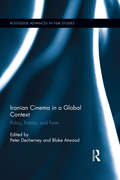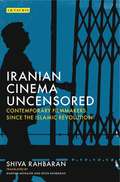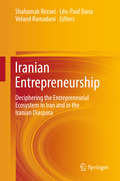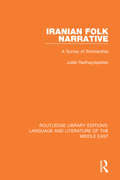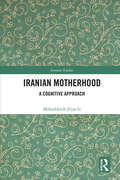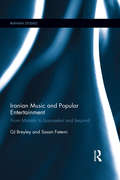- Table View
- List View
Iranian Cinema in a Global Context: Policy, Politics, and Form (Routledge Advances in Film Studies)
by Peter Decherney Blake AtwoodIranian films have been the subject of much critical and scholarly attention over the past several decades, and Iranian filmmakers are mainstays of international film festivals. Yet most of the attention has been focused on a small segment of Iranian film production: auteurist art cinema. Iranian Cinema in a Global Context, on the other hand, takes account of the wide range of Iranian cinema, from popular youth films to low budget underground films. The volume also reassesses the global circulation of Iranian art cinema, looking at its reception at international festivals, in university curricula, and at the Academy Awards. A final theme of the volume explores the intersection between politics and film, with essays on post-Khatami reform influences, representations of ineffective drug policies, and the representation of Jewish characters in Iranian film. Taken together, the essays in this volume present a new definition of the field of Iranian film studies, one that engages global media flows, transmedia interaction, and a heterogeneous Iranian national cinema.
Iranian Cinema Uncensored: Contemporary Film-makers since the Islamic Revolution (International Library of the Moving Image (PDF))
by Shiva RahbaranThe New Iranian Cinema is considered by many to be the most fascinating cultural phenomenon produced within the Islamic Republic of Iran. Containing twelve first-hand interviews with the most renowned film-makers living and working in contemporary Iran, this book provides insights into film-making within a society often at odds with its rulers. Reflecting upon the 1979 revolution and its influence on their work, as well as the effect of their films on Iranian audiences, film-makers such as Abbas Kiarostami and Jafar Panahi highlight the key issues surrounding the reception of Iranian cinema in the West and also its role in the development of Iran's global image. Through these conversations Shiva Rahbaran reveals that the seeds of the New Iranian Cinema were sown long before the revolution, and that Iranian film-makers gave rise to a cinema which became a global phenomenon despite censorship, sanctions and political isolation.
Iranian Culture: Representation and Identity (Iranian Studies)
by Nasrin RahimiehThroughout modern Iranian history, culture has served as a means of imposing unity and cohesion onto society. The Pahlavi monarchs used it to project an image of Iran as an ancient civilisation, re-emerging as an equal to Western nations, while the revolutionaries deployed it to remake the country into an Islamic nation. Just as Iranian culture has been continually re-interpreted, the representations and avocations of Iranian identity vary amongst Iranians across the world. Iranian Culture: Representation and Identity demonstrates these fissures and the incompatibilities that refuse to be written out of national culture, analysing works of literature, popular music, graphic art and film, as well as oral narratives. Using works produced before and after the 1979 revolution, created both inside and outside of Iran, this study reveals neglected complexities and contradictions in the field of Iranian cultural production. It considers how contested claims to culture, whether they originated in Iran or the Iranian diaspora, shape our understanding of this culture and what spaces they create for new articulations of it, and in doing so offers an important re-examination of our collective concept of culture. This book would be an excellent resource for students and scholars of Middle East Studies and Iranian Studies, specifically Iranian culture including film and contemporary literature and the Iranian diaspora.
Iranian Culture: Representation and Identity (Iranian Studies)
by Nasrin RahimiehThroughout modern Iranian history, culture has served as a means of imposing unity and cohesion onto society. The Pahlavi monarchs used it to project an image of Iran as an ancient civilisation, re-emerging as an equal to Western nations, while the revolutionaries deployed it to remake the country into an Islamic nation. Just as Iranian culture has been continually re-interpreted, the representations and avocations of Iranian identity vary amongst Iranians across the world. Iranian Culture: Representation and Identity demonstrates these fissures and the incompatibilities that refuse to be written out of national culture, analysing works of literature, popular music, graphic art and film, as well as oral narratives. Using works produced before and after the 1979 revolution, created both inside and outside of Iran, this study reveals neglected complexities and contradictions in the field of Iranian cultural production. It considers how contested claims to culture, whether they originated in Iran or the Iranian diaspora, shape our understanding of this culture and what spaces they create for new articulations of it, and in doing so offers an important re-examination of our collective concept of culture. This book would be an excellent resource for students and scholars of Middle East Studies and Iranian Studies, specifically Iranian culture including film and contemporary literature and the Iranian diaspora.
Iranian Entrepreneurship: Deciphering the Entrepreneurial Ecosystem in Iran and in the Iranian Diaspora
by Shahamak Rezaei Leo-Paul Dana Veland RamadaniThis book presents a comprehensive, state-of-the-art portrait of entrepreneurship and small business management issues in Iran, and among the Iranian Diaspora. The major contributions in this book address topics such as innovation, female entrepreneurship, social entrepreneurship, migrant entrepreneurship, corporate entrepreneurship, institutional support of entrepreneurial initiatives and more. This book is the outcome of an extensive research endeavor spanning several years and includes the latest contributions from highly respected authors and experts from Iran and beyond.
Iranian Folk Narrative: A Survey of Scholarship (Routledge Library Editions: Language & Literature of the Middle East)
by Juliet RadhayrapetianFor centuries Iran hosted numerous travellers and visitors of diverse nationalities and backgrounds. Many of these travellers left behind documents in which they recorded their observations during their residence in Iran, and these embody a vast range of firsthand information about the land and its people at different periods of time. This book, first published in 1990, takes as its subjects the nature and history of Iranian folk narrative scholarship. The contributions of travellers are given their due recognition as important source documents.
Iranian Folk Narrative: A Survey of Scholarship (Routledge Library Editions: Language & Literature of the Middle East)
by Juliet RadhayrapetianFor centuries Iran hosted numerous travellers and visitors of diverse nationalities and backgrounds. Many of these travellers left behind documents in which they recorded their observations during their residence in Iran, and these embody a vast range of firsthand information about the land and its people at different periods of time. This book, first published in 1990, takes as its subjects the nature and history of Iranian folk narrative scholarship. The contributions of travellers are given their due recognition as important source documents.
Iranian Foreign Policy Since 2001: Alone in the World (Routledge Studies in Middle Eastern Politics)
by Thomas Juneau Sam RazaviExamining Iranian foreign policy, with a focus on the years since 2001, this book analyses the defining feature of Iran’s international and regional posture, its strategic loneliness, and the implications of this for the Islamic Republic’s foreign policy. Iranian Foreign Policy since 2001 offers an in-depth analysis of the key drivers behind Iran’s foreign policy; power, strategic culture, and ideology. In addition, the authors examine Iran’s relations with key countries and regions, including its often tenuous relations with China, Russia and America, as well as its bilateral relations with non-state actors such as Hezbollah. The common thread running throughout the volume is that Iran is alone in the world: regardless of its political manoeuvrings, the Islamic Republic’s regional and international posture is largely one of strategic loneliness. Assimilating contributions from the US, Canada, Europe and Iran, this book provides an international perspective, both at the theoretical and practical levels and is essential reading for those with an interest in Middle Eastern Politics, International Relations and Political Science more broadly.
Iranian Foreign Policy Since 2001: Alone in the World (Routledge Studies in Middle Eastern Politics)
by Thomas Juneau Sam RazaviExamining Iranian foreign policy, with a focus on the years since 2001, this book analyses the defining feature of Iran’s international and regional posture, its strategic loneliness, and the implications of this for the Islamic Republic’s foreign policy. Iranian Foreign Policy since 2001 offers an in-depth analysis of the key drivers behind Iran’s foreign policy; power, strategic culture, and ideology. In addition, the authors examine Iran’s relations with key countries and regions, including its often tenuous relations with China, Russia and America, as well as its bilateral relations with non-state actors such as Hezbollah. The common thread running throughout the volume is that Iran is alone in the world: regardless of its political manoeuvrings, the Islamic Republic’s regional and international posture is largely one of strategic loneliness. Assimilating contributions from the US, Canada, Europe and Iran, this book provides an international perspective, both at the theoretical and practical levels and is essential reading for those with an interest in Middle Eastern Politics, International Relations and Political Science more broadly.
Iranian Identity and Cosmopolitanism: Spheres of Belonging (Suspensions: Contemporary Middle Eastern and Islamicate Thought)
by Lucian StoneSince cosmopolitanism has often been conceived as a tenet of 'Western civilization' that emanates from its Enlightenment-based origins in a humanist age of modernity, Iranian Identity and Cosmopolitanism: Spheres of Belonging advances a highly innovative gesture by contemplating the implications and relevance of the idea in a so-called non-Western cultural territory. The particularities of the Iranian and Islamic context shed new light on advancements and obstacles to cosmopolitan praxis. The volume provides four principle disciplinary assessments of cosmopolitanism: philosophy, political science, sociology, and cultural studies,including literary criticism. The authors in this collection critically examine topics including the historical encounter between Iranian and Western thinkers and its impact on Iranian political ideals; the tension between maintaining apolitical-theology rooted in metaphysical assumptions and the prerequisite of secularism in cosmopolitan and democratic philosophies. This highly innovative volume will be of interest to scholars and students of Middle Eastern and Iranian Studies, Islamic Studies, Globalization, Political Science and Philosophy.
Iranian Identity and Cosmopolitanism: Spheres of Belonging (Suspensions: Contemporary Middle Eastern and Islamicate Thought)
by Lucian StoneSince cosmopolitanism has often been conceived as a tenet of 'Western civilization' that emanates from its Enlightenment-based origins in a humanist age of modernity, Iranian Identity and Cosmopolitanism: Spheres of Belonging advances a highly innovative gesture by contemplating the implications and relevance of the idea in a so-called non-Western cultural territory. The particularities of the Iranian and Islamic context shed new light on advancements and obstacles to cosmopolitan praxis. The volume provides four principle disciplinary assessments of cosmopolitanism: philosophy, political science, sociology, and cultural studies,including literary criticism. The authors in this collection critically examine topics including the historical encounter between Iranian and Western thinkers and its impact on Iranian political ideals; the tension between maintaining apolitical-theology rooted in metaphysical assumptions and the prerequisite of secularism in cosmopolitan and democratic philosophies. This highly innovative volume will be of interest to scholars and students of Middle Eastern and Iranian Studies, Islamic Studies, Globalization, Political Science and Philosophy.
Iranian Immigration to Israel: History and Voices, in the Shadow of Kings (Routledge Studies in Middle Eastern Society)
by Ali L. EzzatyarExploring the fascinating history behind Iranian-Jewish immigration to Israel, this book offers a rare and untold history of one of Israel’s Middle Eastern Jewish populations. Over the twentieth century, thousands among Iran’s Jewish community left their ancestral homes and immigrated to the Jewish State, while thousands remained in Iran, even after the birth of the Islamic Republic of Iran. Using first-hand narratives, the evolution of Zionist activities and recruitment in Iran over the last century is covered, alongside an Iranian-Jewish population that, unlike other Middle Eastern Jewish communities, did not ultimately arrive in the Holy Land as a majority of their community. For those that did arrive (or, make aliyah) the Israeli nation-building process had unique ramifications. The integrative process and current status of the Iranian community in Israel is also examined, providing an intimate picture of Iranian life in Israel, nearly 75 years after Israel’s establishment. A natural addition to any collection on Jewish or Israeli history, and essential reading for a full understanding of Iran-Israel relations, students of Israeli nation-building and affairs, as well as Iranian history, demographics, and politics will find this book invaluable.
Iranian Immigration to Israel: History and Voices, in the Shadow of Kings (Routledge Studies in Middle Eastern Society)
by Ali L. EzzatyarExploring the fascinating history behind Iranian-Jewish immigration to Israel, this book offers a rare and untold history of one of Israel’s Middle Eastern Jewish populations. Over the twentieth century, thousands among Iran’s Jewish community left their ancestral homes and immigrated to the Jewish State, while thousands remained in Iran, even after the birth of the Islamic Republic of Iran. Using first-hand narratives, the evolution of Zionist activities and recruitment in Iran over the last century is covered, alongside an Iranian-Jewish population that, unlike other Middle Eastern Jewish communities, did not ultimately arrive in the Holy Land as a majority of their community. For those that did arrive (or, make aliyah) the Israeli nation-building process had unique ramifications. The integrative process and current status of the Iranian community in Israel is also examined, providing an intimate picture of Iranian life in Israel, nearly 75 years after Israel’s establishment. A natural addition to any collection on Jewish or Israeli history, and essential reading for a full understanding of Iran-Israel relations, students of Israeli nation-building and affairs, as well as Iranian history, demographics, and politics will find this book invaluable.
Iranian Islam: The Concept of the Individual
by Fereshteh Ahmadi Nader AhmadiThe author examines from different perspectives (theological and philosophical as well as socio-political and historical) the significance of the concept of the individual in the ways of thinking of Iranians. This book establishes that the mystical dimension of Islamic thought, the divine nature of Islamic law and, the mode of relationship between ruler and the ruled, in combination, counteracted growth of concern for the individual self in Iranian thought.
Iranian Jews in Israel: Between Persian Cultural Identity and Israeli Nationalism (Library of Modern Middle East Studies)
by Alessandra CecolinRecent, post-revolutionary Iranian cinema has of course gained the attention of international audiences who have been struck by its powerful, poetic and often explicitly political explorations. Yet mainstream, pre-revolutionary Iranian cinema, with a history stretching back to the early twentieth century, has been perceived in the main as lacking in artistic merit and, crucially, as apolitical in content. This highly readable history of Iran as revealed through the full breadth of its cinema re-reads the films themselves to tell the full story of shifting political, economic and social situations. Sadr argues that embedded within even the seemingly least noteworthy of mainstream Iranian films, we find themes and characterisations which reveal the political contexts of their time and which express the ideological underpinnings of a society. Beginning with the introduction of cinema to Iran through the Iranian monarchy the book covers the broad spectrum of Iran's cinema, offering vivid descriptions of all key films. Iranian Cinema looks at recurring themes and tropes, such as the rural versus the 'corrupt' city and, recently, the preponderance of images of childhood, and asks what these have revealed about Iranian society. The author brings the story up to date explaining Iranian filmmaking after the events of September 11, from Mohsen Makhmalbaf's astonishing Kandahar to Saddiq Barmak's angry work Osama, to explore this most recent and breathtaking revival in Iranian cinema.
The Iranian Metaphysicals: Explorations in Science, Islam, and the Uncanny
by Alireza DoostdarWhat do the occult sciences, séances with the souls of the dead, and appeals to saintly powers have to do with rationality? Since the late nineteenth century, modernizing intellectuals, religious leaders, and statesmen in Iran have attempted to curtail many such practices as "superstitious," instead encouraging the development of rational religious sensibilities and dispositions. However, far from diminishing the diverse methods through which Iranians engage with the immaterial realm, these rationalizing processes have multiplied the possibilities for metaphysical experimentation. The Iranian Metaphysicals examines these experiments and their transformations over the past century. Drawing on years of ethnographic and archival research, Alireza Doostdar shows that metaphysical experimentation lies at the center of some of the most influential intellectual and religious movements in modern Iran. These forms of exploration have not only produced a plurality of rational orientations toward metaphysical phenomena but have also fundamentally shaped what is understood as orthodox Shi‘i Islam, including the forms of Islamic rationality at the heart of projects for building and sustaining an Islamic Republic. Delving into frequently neglected aspects of Iranian spirituality, politics, and intellectual inquiry, The Iranian Metaphysicals challenges widely held assumptions about Islam, rationality, and the relationship between science and religion.
The Iranian Metaphysicals: Explorations in Science, Islam, and the Uncanny
by Alireza DoostdarWhat do the occult sciences, séances with the souls of the dead, and appeals to saintly powers have to do with rationality? Since the late nineteenth century, modernizing intellectuals, religious leaders, and statesmen in Iran have attempted to curtail many such practices as "superstitious," instead encouraging the development of rational religious sensibilities and dispositions. However, far from diminishing the diverse methods through which Iranians engage with the immaterial realm, these rationalizing processes have multiplied the possibilities for metaphysical experimentation. The Iranian Metaphysicals examines these experiments and their transformations over the past century. Drawing on years of ethnographic and archival research, Alireza Doostdar shows that metaphysical experimentation lies at the center of some of the most influential intellectual and religious movements in modern Iran. These forms of exploration have not only produced a plurality of rational orientations toward metaphysical phenomena but have also fundamentally shaped what is understood as orthodox Shi‘i Islam, including the forms of Islamic rationality at the heart of projects for building and sustaining an Islamic Republic. Delving into frequently neglected aspects of Iranian spirituality, politics, and intellectual inquiry, The Iranian Metaphysicals challenges widely held assumptions about Islam, rationality, and the relationship between science and religion.
Iranian Motherhood: A Cognitive Approach (Iranian Studies)
by Mohaddeseh ZiyachiThis book characterises the problematic status of motherhood in present-day Iranian society – that is, problem in the Foucauldian sense of an object of thought and a source of tension, not as a pathological issue – and explains the historical processes contributing to this problematisation. Taking an interdisciplinary approach, the author draws on a cognitive anthropological perspective whilst incorporating ethnographic, historical, and evolutionary viewpoints. By applying this perspective to the current cultural model of motherhood, and considering specific social, political, and economic factors in Iran, the author provides an exhaustive, contextualised understanding of the motherhood problem and its multidirectional changes throughout time. The book follows a multi-method framework and combines qualitative ethnographic and auto-ethnographic data with historical evidence and comparative data. As such, it also contributes to the women's movement in Iran by fostering discussion on women's issues and demystifying women's understandings and experiences. The book will appeal to those working in a range of disciplines, including gender studies, cognitive anthropology and Iranian history. Written in non-technical language, and providing insights into the problem of motherhood in comparable contexts, the book will also be of interest to general readers.
Iranian Motherhood: A Cognitive Approach (Iranian Studies)
by Mohaddeseh ZiyachiThis book characterises the problematic status of motherhood in present-day Iranian society – that is, problem in the Foucauldian sense of an object of thought and a source of tension, not as a pathological issue – and explains the historical processes contributing to this problematisation. Taking an interdisciplinary approach, the author draws on a cognitive anthropological perspective whilst incorporating ethnographic, historical, and evolutionary viewpoints. By applying this perspective to the current cultural model of motherhood, and considering specific social, political, and economic factors in Iran, the author provides an exhaustive, contextualised understanding of the motherhood problem and its multidirectional changes throughout time. The book follows a multi-method framework and combines qualitative ethnographic and auto-ethnographic data with historical evidence and comparative data. As such, it also contributes to the women's movement in Iran by fostering discussion on women's issues and demystifying women's understandings and experiences. The book will appeal to those working in a range of disciplines, including gender studies, cognitive anthropology and Iranian history. Written in non-technical language, and providing insights into the problem of motherhood in comparable contexts, the book will also be of interest to general readers.
Iranian Music and Popular Entertainment: From Motrebi to Losanjelesi and Beyond (Iranian Studies)
by Sasan Fatemi GJ BreyleyThe word motreb finds its roots in the Arabic verb taraba, meaning ‘to make happy.’ Originally denoting all musicians in Iran, motrebi came to be associated, pejoratively, with the cheerful vulgarity of the lowbrow entertainer. In Iranian Music and Popular Entertainment, GJ Breyley and Sasan Fatemi examine the historically overlooked motrebi milieu, with its marginalized characters, from luti to gardan koloft and mashti, as well as the tenacity of motreb who continued their careers against all odds. They then turn to losanjelesi, the most pervasive form of Iranian popular music that developed as motrebi declined, and related musical forms in Iran and its diasporic popular cultural centre, Los Angeles. For the first time in English, the book makes available musical transcriptions, analysis and lyrics that illustrate the complexities of this history. As it presents the findings of the authors’ years of ethnographic work with the history’s protagonists, from senior motreb to pop-rock stars, the book reveals parallels between the decline of motrebi and the rise of ‘modernity.’ In the twentieth century, the fate of Tehran’s motrebi music was shaped by the social and urban polarization that ensued from the modern market economy, and losanjelesi would be similarly affected by transnational relations, revolution, war and migration. Through its detailed and informed examination of Iranian popular music, this study reveals much about the values and anxieties of Iranian society, and is a valuable resource for students and scholars of Iranian society and history.
Iranian Music and Popular Entertainment: From Motrebi to Losanjelesi and Beyond (Iranian Studies)
by Sasan Fatemi GJ BreyleyThe word motreb finds its roots in the Arabic verb taraba, meaning ‘to make happy.’ Originally denoting all musicians in Iran, motrebi came to be associated, pejoratively, with the cheerful vulgarity of the lowbrow entertainer. In Iranian Music and Popular Entertainment, GJ Breyley and Sasan Fatemi examine the historically overlooked motrebi milieu, with its marginalized characters, from luti to gardan koloft and mashti, as well as the tenacity of motreb who continued their careers against all odds. They then turn to losanjelesi, the most pervasive form of Iranian popular music that developed as motrebi declined, and related musical forms in Iran and its diasporic popular cultural centre, Los Angeles. For the first time in English, the book makes available musical transcriptions, analysis and lyrics that illustrate the complexities of this history. As it presents the findings of the authors’ years of ethnographic work with the history’s protagonists, from senior motreb to pop-rock stars, the book reveals parallels between the decline of motrebi and the rise of ‘modernity.’ In the twentieth century, the fate of Tehran’s motrebi music was shaped by the social and urban polarization that ensued from the modern market economy, and losanjelesi would be similarly affected by transnational relations, revolution, war and migration. Through its detailed and informed examination of Iranian popular music, this study reveals much about the values and anxieties of Iranian society, and is a valuable resource for students and scholars of Iranian society and history.
The Iranian Political Language: From the Late Nineteenth Century to the Present
by Yadullah ShahibzadehIn this detailed study of modern Iran, Yadullah Shahibzadeh examines changes in people's understanding of politics and democracy. The book aims to overcome the shortcomings of traditional historiography by challenging the monopoly of intellectuals' perspectives and demonstrating the intellectual and political agency of the ordinary people.
Iranian Refugees in Transit: Exile and the Politics of Survival in Turkey after the 1979 Revolution
by Maral JefroudiMaral Jefroudi presents a comprehensive picture of one of the largest migration waves in contemporary history by analyzing refugees' interactions with the Turkish State, the UNHCR, and within the community of Iranians in transit after the 1979 revolution.Iranian Refugees in Transit unveils the rich history of political engagement among Iranian refugees before their arrival in Turkey, contextualised within Turkey's own landscape of political and ethnic conflicts. Jefroudi expertly examines the intersectional distribution of precarity among refugees. By bringing together interviews with refugees from the period, analyzing cultural products by and on them, and tracing their footsteps in newspapers and scholarly literature, this book fills a significant gap in Turkey's migration history. Through a critical historical analysis of the international asylumsystem, Iranian Refugees in Transit offers valuable insights into the dynamics of the current 'refugee crisis'.
Iranian Refugees in Transit: Exile and the Politics of Survival in Turkey after the 1979 Revolution
by Maral JefroudiMaral Jefroudi presents a comprehensive picture of one of the largest migration waves in contemporary history by analyzing refugees' interactions with the Turkish State, the UNHCR, and within the community of Iranians in transit after the 1979 revolution.Iranian Refugees in Transit unveils the rich history of political engagement among Iranian refugees before their arrival in Turkey, contextualised within Turkey's own landscape of political and ethnic conflicts. Jefroudi expertly examines the intersectional distribution of precarity among refugees. By bringing together interviews with refugees from the period, analyzing cultural products by and on them, and tracing their footsteps in newspapers and scholarly literature, this book fills a significant gap in Turkey's migration history. Through a critical historical analysis of the international asylumsystem, Iranian Refugees in Transit offers valuable insights into the dynamics of the current 'refugee crisis'.
The Iranian Revolution Then And Now: Indicators Of Regime Instability
by Dariush ZahediIn The Iranian Revolution Then and Now , Dariush Zahedi assesses the Islamic Republic's potential for revolution through an in-depth, theoretically informed, comparative analysis of the present with 1979 pre-Revolutionary Iran. Zahedi discusses how the potential for a revolutionary coup is based on two things: the inherent defects and vulnerabilities in the regime and the coordinated actions of the social groups and individuals opposed to the regime. He also identifies two ideal-typical forms of revolutionary change. }In The Iranian Revolution Then and Now , Dariush Zahedi assesses the Islamic Republic's potential for revolution through an in-depth, theoretically informed, comparative analysis of the present with 1979 pre-Revolutionary Iran. Zahedi discusses how the potential for a revolutionary coup is based on two things: the inherent defects and vulnerabilities in the regime and the coordinated actions of the social groups and individuals opposed to the regime. He also identifies two ideal-typical forms of revolutionary change (the regime collapses on its own, or, the regime is overthrown). He concludes that the chances for overthrowing the present regime are moderate. }
